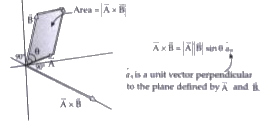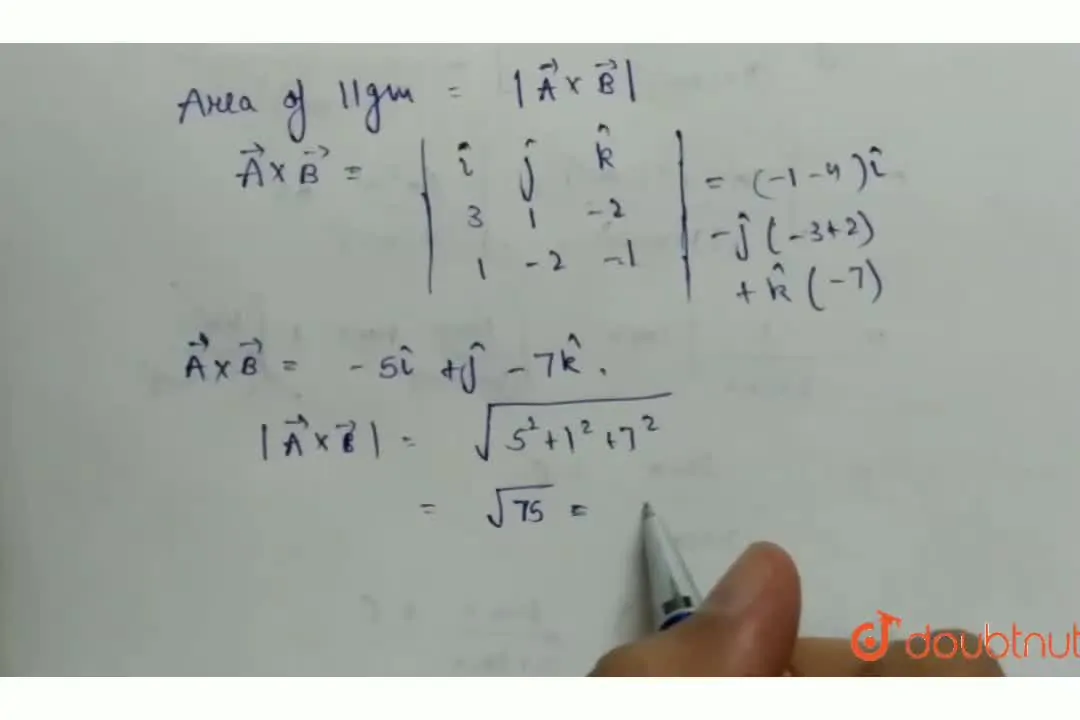Find the area of parallelogram whose adjacent sides are represented by the vectors 3ˆi+ˆj−2ˆkandˆi−2ˆj−ˆk.
The correct Answer is:√612 sq, units
Step by step video, text & image solution for Find the area of parallelogram whose adjacent sides are represented by the vectors 3hat(i)+hat(j)-2hat(k) and hat(i)-2hat(j)-hat(k). by Maths experts to help you in doubts & scoring excellent marks in Class 12 exams.
Related Playlists
- BOOK - ARIHANT MATHSCHAPTER - PRODUCT OF VECTORSEXERCISE - Exercise For Session 310videos
PRODUCT OF VECTORS
- BOOK - ARIHANT MATHSCHAPTER - PRODUCT OF VECTORSEXERCISE - Exercise For Session 410videos
PRODUCT OF VECTORS
- BOOK - ARIHANT MATHSCHAPTER - PRODUCT OF VECTORSEXERCISE - Exercise For Session 113videos
PRODUCT OF VECTORS
- BOOK - ARIHANT MATHSCHAPTER - PROBABILITYEXERCISE - Exercise (Questions Asked In Previous 13 Years Exam)55videos
PROBABILITY
- BOOK - ARIHANT MATHSCHAPTER - PROPERTIES AND SOLUTION OF TRIANGLES EXERCISE - Exercise (Questions Asked In Previous 13 Years Exam)21videos
PROPERTIES AND SOLUTION OF TRIANGLES
Similar Questions
Find the area of the parallelogram whose adjacent sides are represented by the vectors (3ˆi+ˆj−2ˆk)and(ˆi−3ˆj+4ˆk).
View SolutionFind the area of a parallelogram whose adjacent sides are represented by the vectors 2ˆi−3ˆkand4ˆj+2ˆk .
View SolutionThe cross product of two vectors gives a vector perpendicular to the plane containing the vectors.

Area of parallelogram whose adjacent sides are represented by the vectors →a=2ˆi−ˆj+ˆk and →b=3ˆi−ˆj is sq. units.View SolutionThe area of the parallelogram whose sides are represented by the vector ˆj+3ˆk and ˆi+2ˆj−ˆk is
View SolutionFind the area of the parallelogram whose adjacent sides are represented by the vectors (i) →a=ˆi+2ˆj+3ˆk and →b=−3ˆi−2ˆj+ˆk (ii) →a=(3ˆi+ˆj+4ˆk) and →b=(ˆi−ˆj+ˆk) (iii) →a=2ˆi+ˆj+3ˆkand→b=ˆi−ˆj (iv)→b=2ˆiand→b=3ˆj.
View SolutionFind the area of a parallelogram whose adjacent sides are given by the vectors →a=3ˆi+ˆj+4ˆkand →b=ˆi−ˆj+ˆk.
View SolutionThe unit vector parallel to one of the diagonal of the parallelogram whose two adjacent sides are represented by the vectors 2ˆi+4ˆj−5ˆk and ˆi+2ˆj+3ˆk is
View SolutionCalculate the area of the parallelogram when adjacent sides are given by the vectors →A=ˆi+2ˆj+3ˆk and →B=2ˆi−3ˆj+ˆk.
View SolutionFind the area of the parallelogram whose adjacent sides are determined by the vectors →a=ˆi−ˆj+3ˆk and →b=2ˆi−7ˆj+ˆk.
View SolutionFind the area of the parallelogram whose adjacent sides are determined by the vectors →a=ˆi−ˆj+3ˆkand→b=2ˆi−7ˆj+ˆk.
View Solution


